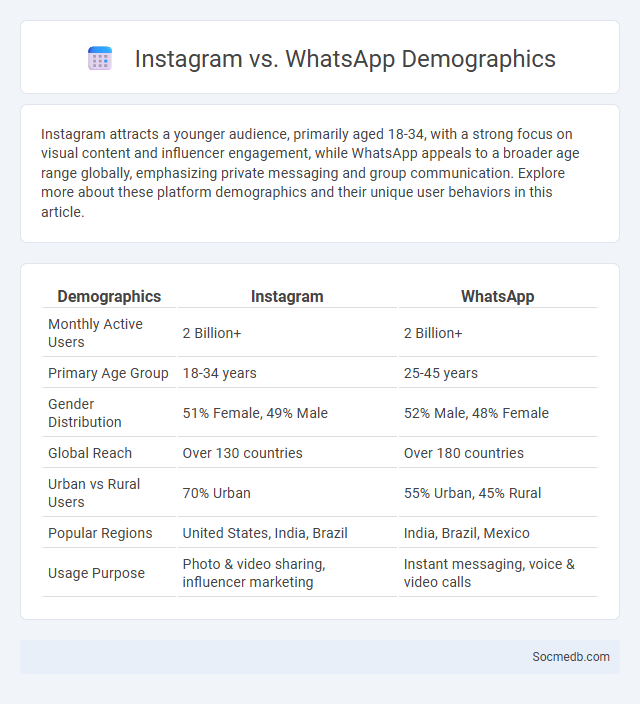
Photo illustration: Instagram vs WhatsApp demographics
Instagram attracts a younger audience, primarily aged 18-34, with a strong focus on visual content and influencer engagement, while WhatsApp appeals to a broader age range globally, emphasizing private messaging and group communication. Explore more about these platform demographics and their unique user behaviors in this article.
Table of Comparison
| Demographics | ||
|---|---|---|
| Monthly Active Users | 2 Billion+ | 2 Billion+ |
| Primary Age Group | 18-34 years | 25-45 years |
| Gender Distribution | 51% Female, 49% Male | 52% Male, 48% Female |
| Global Reach | Over 130 countries | Over 180 countries |
| Urban vs Rural Users | 70% Urban | 55% Urban, 45% Rural |
| Popular Regions | United States, India, Brazil | India, Brazil, Mexico |
| Usage Purpose | Photo & video sharing, influencer marketing | Instant messaging, voice & video calls |
Introduction to Instagram and WhatsApp User Demographics
Instagram boasts over 2 billion monthly active users, predominantly aged 18 to 34, making it a vital platform for targeting younger audiences with visual content. WhatsApp, with more than 2 billion users globally, is widely used across diverse age groups for instant messaging and voice calls, emphasizing personal and group communication. Understanding these demographic insights helps you tailor content and engagement strategies effectively on each platform.
Global User Base Comparison: Instagram vs WhatsApp
Instagram boasts over 2 billion monthly active users, making it a leading platform for visual content sharing and influencer marketing. WhatsApp, owned by Meta, supports more than 2.5 billion monthly active users worldwide, primarily focusing on instant messaging and secure communication. Both platforms serve distinct user needs, with WhatsApp dominating messaging while Instagram excels in social media engagement and brand promotion.
Age Distribution: Instagram vs WhatsApp
Instagram's user base skews younger, with approximately 67% of users aged 18-29, making it a prime platform for reaching Gen Z and Millennials. WhatsApp, on the other hand, enjoys broader age distribution, with significant usage among 30-49 and 50+ age groups, catering to a more diverse demographic. Understanding these differences helps you tailor your social media strategy effectively across platforms.
Gender Breakdown Across Platforms
Facebook's user base consists of approximately 56% female and 44% male users, while Instagram shows a similar trend with around 57% women and 43% men engaging on the platform. Twitter presents a more balanced gender distribution, with males representing roughly 54% and females 46% of the audience. Snapchat attracts a predominantly female demographic, with women accounting for nearly 61% of its users compared to 39% male participation.
Geographic Reach and Regional Preferences
Social media platforms enable vast geographic reach, connecting Your content to diverse audiences across continents instantly. Tailoring posts to regional preferences, such as language, cultural norms, and trending topics, significantly boosts engagement and relevance. Utilizing geo-targeting tools and analytics helps optimize campaigns by aligning with local behaviors and peak activity times.
Urban vs Rural Usage Patterns
Urban areas exhibit higher social media engagement due to better internet infrastructure and greater smartphone penetration, with platforms like Instagram and Twitter dominating usage. Rural regions tend to rely more on Facebook and WhatsApp, reflecting preferences for community-focused communication and lower bandwidth requirements. Differences in content consumption patterns highlight the impact of demographic factors, digital literacy, and economic conditions on social media behavior in urban versus rural populations.
Income and Educational Background of Users
Social media users with higher incomes often exhibit increased engagement with premium content and targeted advertisements, reflecting greater purchasing power and brand affinity. Educational background influences platform preferences and interaction styles, with college-educated users more likely to participate in professional networking sites like LinkedIn. Income and education levels combined significantly impact user behavior, content consumption, and advertising responsiveness across social media channels.
Engagement Levels by Demographic
Engagement levels on social media vary significantly across demographics, with millennials and Gen Z exhibiting the highest interaction rates on platforms like Instagram, TikTok, and Snapchat. Studies show that users aged 18-34 spend an average of 30-45 minutes daily engaging with content, while older demographics, such as those aged 50 and above, show lower engagement but growing activity primarily on Facebook. Gender-wise, women tend to engage more with visual and lifestyle content, whereas men are more interactive with sports and technology posts, influencing targeted marketing strategies.
Popular Content Types Among Different Demographics
Video content dominates social media engagement across age groups, with younger users favoring short-form videos on platforms like TikTok and Instagram Reels, while older demographics engage more with longer YouTube videos and Facebook posts. Visual content such as images and infographics is highly effective among millennials and Gen X, who appreciate informative and shareable formats. Text-driven content, including articles and status updates, tends to resonate more with older adults, who prioritize in-depth information and community discussions.
Implications for Marketers: Choosing the Right Platform
Selecting the right social media platform is crucial for marketers aiming to reach their target audience effectively. Understanding demographic data, user engagement patterns, and platform-specific features allows you to tailor content that maximizes impact and drives brand awareness. Focus on platforms where your audience is most active to optimize marketing ROI and ensure meaningful interactions.
 socmedb.com
socmedb.com